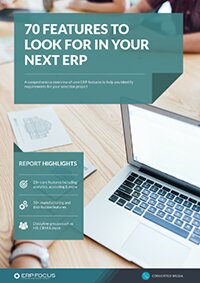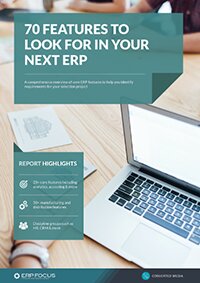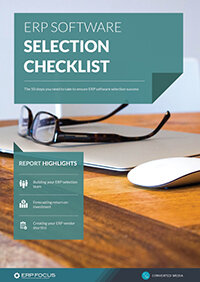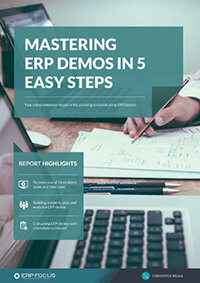10 Core ERP Features to Consider For Your Business
There are many ERP features in the enterprise software market, more so when you consider apps and modules for industry-specific systems. Whilst those industry-centric companies - such as distributors or process manufacturers - will have specific modules to meet those needs, it can be difficult to know what ERP features you need on a more general scale.
So without further delay, here are 10 core ERP features to consider as part of your selection process.
ERP Feature 1: Finance and accounting
Money in any language is at the center of every business. Even nonprofits record how much money they have and will need. This puts financial and accounting at the center of ERP systems as well. Many of today’s ERP systems began life as accounting systems and developed by adding other components such as sales, purchasing, and inventory to become, eventually, the ERP systems we recognize today.
Few ERP systems do not include accounting and those will always include integrations with one or more free-standing accounting software. This list contains many individual, core ERP features of modern ERP systems. What makes them a system is the way they integrate.
Sales, engineering, accounting and other business functions cannot live in their individual silos today. ERP keeps a common flow of information available to all the singers in the choir and lets them all sing from the same sheet even when they are in different buildings or on different continents.
GET ERP RESEARCH & KNOWLEDGE RIGHT TO YOUR INBOX
Covering the key issues faced by businesses selecting and implementing ERP.
ERP Feature 2: Sales Management
Businesses depend on sales, whether small like an online order for some immediate desire, or large like an entire commercial real estate development. When sales are part of our ERP system, there is a direct database link to accounting when the sale is complete and we have an offset in cash or accounts receivable. When the sale is first made and before it consummates, there is a link to inventory or our production process to find whatever the customer wants us to deliver.
ERP Feature 3: Inventory management
Many businesses sell physical things. Those things make up inventory. ERP systems track the quantity of those things recording the count of each in however many specific locations each occupies in our stockrooms. Many ERPs track the condition of those things too, recording factors such as temperature and humidity of the storage areas.
Inventory includes the things ready for immediate sale and things that are still in production and will be ready for eventual sale and we call this category work in process. Another category is called raw materials and includes materials owned by the business that have yet to enter into any conversion processes.
In addition to quantity, ERP tracks the value of inventory. That value will follow the specific valuation rules as defined in generally accepted accounting practices. The sum of the values for each item in inventory is the value in the accounting system for the asset we know as inventory.
ERP Feature 4: Purchasing and supply chain
All businesses need to buy things. All businesses need to pay their bills too. Whether you own a small business and only a simple check writing application is needed, or you require a much more comprehensive system with the ability to create purchase orders for specific items directed to certain jobs, an ERP system has you covered.
Beyond transactional uses, purchasing and supply chain components of ERP will help track which suppliers provide what merchandise and the ability to record qualitative data that will help select the best suppliers as needed.
This module will link to accounting so the bank balance reflects the checks written. It also connects to inventory and various expense accounts to record where the value from that check should be recorded. Quality control records how well the purchases meet standards and ensures the products made from those purchases meet the expectations of customers and compliance regulations.
Guide: 70 features to look for in your next ERP
ERP Feature 5: Business process controls
ERP will help your business manage its processes and stay in control of any situation. These controls can be simple, such as an alert when a customer order is due for shipment today but not yet recorded. The controls can be quite complex too. For example, each measurement in the quality processes can trigger an immediate alert that it is beyond the statistical limits and help choose whether secondary measurements are required or if this item should be reworked.
ERP Feature 6: Jobs and projects
ERP provides a business with the tools to relate revenue and expenses to categories that fit the needs of your business. Manufacturers can track the profit related to a specific order or all orders for a certain customer. Construction contractors can track revenue and expenses over extended periods related to a building project. Software developers can link development costs to a specific future revision of an application. ERP can help your business too.
ERP Feature 7: Material requirements planning
These applications were useful management tools even before they were called “enterprise resource planning” systems. They begin with demands that can be specific sales orders in the backlog. To these specific demands, we add expected or forecasted sales of various products in time periods.
Each product has a bill of materials and MRP divides the product using the bills into each component material. MRP then compares the future needs of that component to the quantity on hand now and any expected supplier deliveries and calculates if additional component materials are required. If so, it suggests purchase orders and the date those purchases should be made and delivered.
ERP Feature 8: Business intelligence (BI)
Every item of data in your ERP system can be extracted, manipulated, filtered, and sorted to create exactly the report needed when it is needed. This information helps top management better do its job leading the business. Business intelligence can also guide people at every level in the business to make the best possible choices immediately at the lowest possible level with confidence and speed.
By building rules into the business intelligence system, we can build dashboards for any system user that show their situation in real-time with a direction that identifies within narrow limits what action is required next. Often we can combine that direction with software or hardware robotics to carry out that direction.
ERP Feature 9: Customer requirements planning
Successful, well-run businesses know their customers. CRM as a part of your ERP system allows any business to know its customers well. How long have they been a customer and what products or services have they bought? CRM can also tell how profitable your customers have been.
CRM links to open quotations and automatically links successful bids to create a new sales order entry. CRM tracks marketing campaigns providing you with the knowledge of which were successful and the information you need to generate campaigns in the future that are even more successful.
ERP Feature 10: Human resources
Nearly every business employs some of its workforce. This ERP tool goes well beyond simply recording whose application you have for various jobs and providing a place to keep their emergency contacts and tax withholding statements.
How many people will be required next year and what qualifications will they have? Which current employees can fill those future positions and what additional training will they require? When will you need to begin recruiting for the remaining positions? What goals do your employees have and how can your business help them attain those goals?
How well did your employees meet their past goals? Are they the employees you need tomorrow or do some need remedial training? What records do you need to retain to meet governmental compliance requirements? ERP is your data collector and analytical tool for all these needs.
Free white paper

70 features to look for in your next ERP
A comprehensive guide to help you identify requirements for your ERP selection

Featured white papers
-

ERP Software Pricing Guide
Get the latest pricing information on over 80 popular ERP systems, and learn how to budget for your ERP project in our free guide
Download -

60-Step ERP Selection Checklist
Get the comprehensive checklist for your ERP selection project
Download -

ERP Demo Guide & Scorecard
Master your ERP demo with 5 easy steps using our free guide (includes demo scorecard)
Download
Related articles
-

The best ERP systems for process manufacturing
Consider these ERP systems when selecting your next process manufacturing ERP
-

CMMC Compliance: What Aerospace and Defense Manufacturers Need to Know
Key insights on CMMC compliance, deadlines, and securing DoD contracts with CMMC 2.0 certificatio...
-

5 ERP pricing definitions you need to understand
Have you mastered the ERP pricing lexicon yet? Getting to grips with these five definitions is a ...

